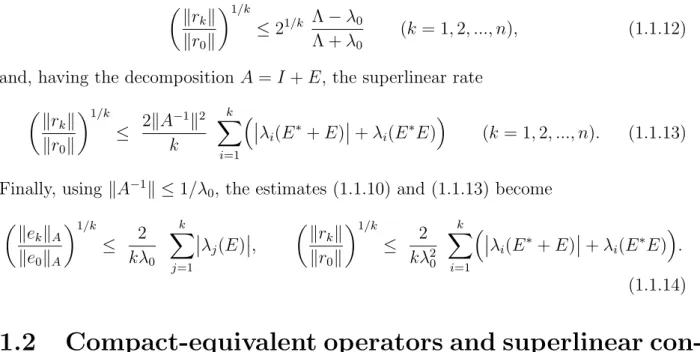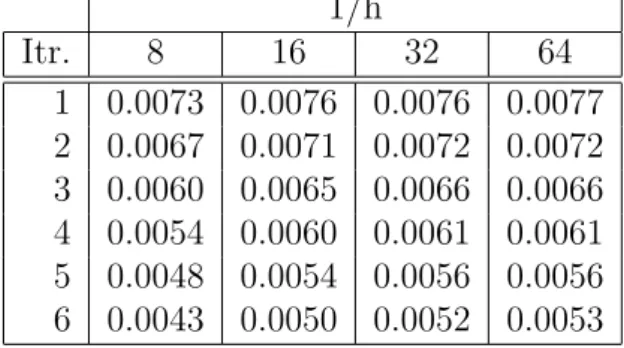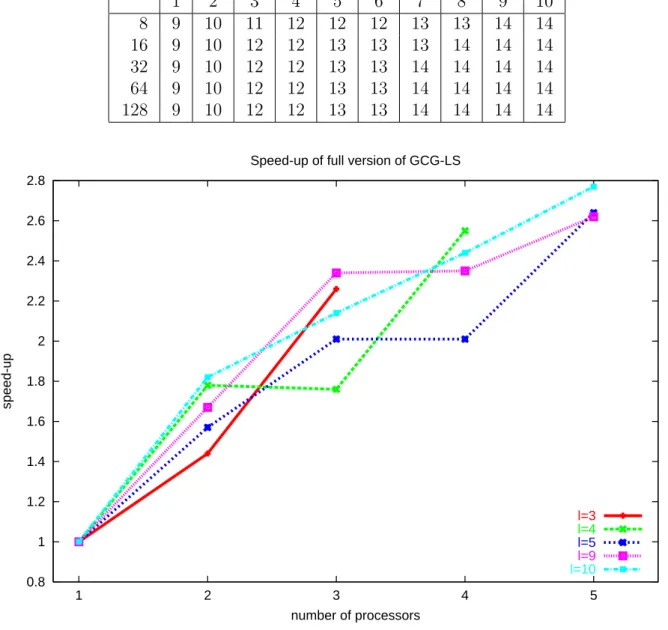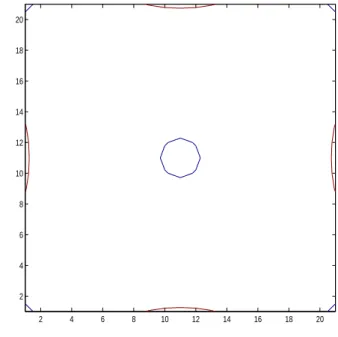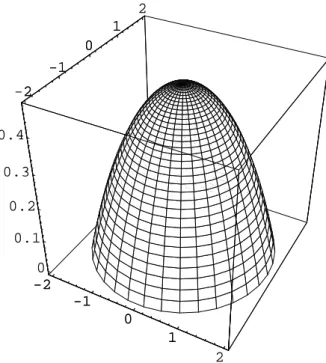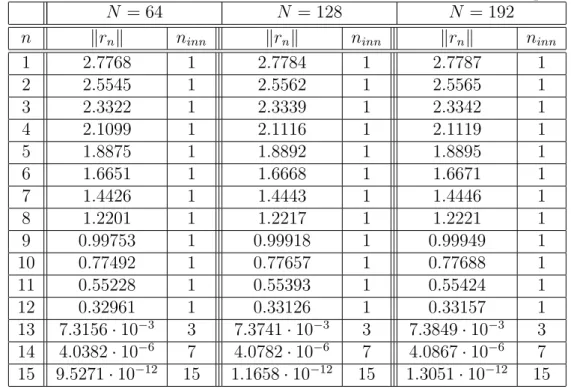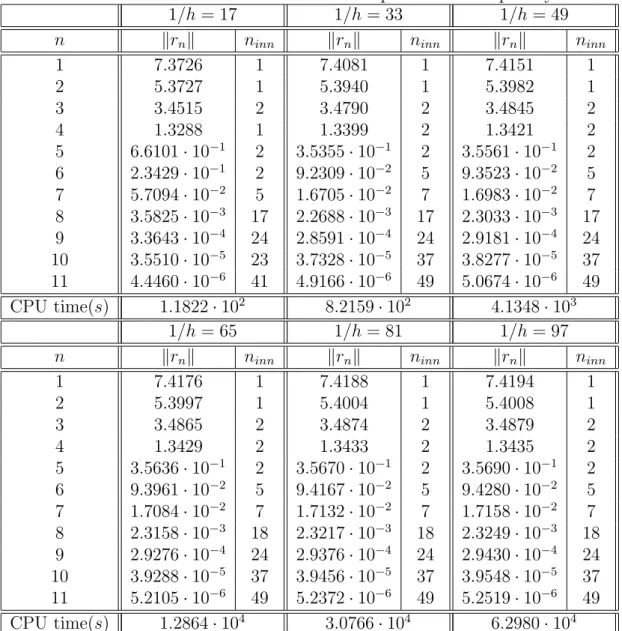Operator methods for the numerical solution of elliptic PDE problems
D.Sc. dissertation Kar´ atson J´ anos
ELTE, Budapest, 2011
Contents
I Iterative methods based on operator preconditioning 1
1 Linear problems 2
1.1 Preliminaries . . . 2
1.1.1 Basic ideas . . . 2
1.1.2 Conjugate gradient algorithms . . . 5
1.2 Compact-equivalent operators and superlinear convergence . . . 6
1.2.1 S-bounded and S-coercive operators . . . 7
1.2.2 Compact-equivalent operators . . . 11
1.2.3 Mesh independent superlinear convergence in Hilbert space . . . 14
1.2.4 Mesh independent superlinear convergence for elliptic problems . . 22
1.3 Equivalent S-bounded andS-coercive operators and linear convergence . . 27
1.3.1 Mesh independent linear convergence in Hilbert space . . . 28
1.3.2 Mesh independent linear convergence for elliptic problems . . . 31
1.4 Symmetric part preconditioning . . . 32
1.4.1 Strong symmetric part and mesh independent convergence . . . 33
1.4.2 Weak symmetric part and mesh independent convergence . . . 37
1.5 Applications to efficient computational algorithms . . . 40
1.5.1 Helmholtz preconditioner for regular convection-diffusion equations 40 1.5.2 Convection problems for viscous fluids . . . 41
1.5.3 Scaling for problems with variable diffusion coefficients . . . 42
1.5.4 Decoupled preconditioners for linearized air pollution systems . . . 42
1.5.5 Parallelization on a cluster of computers . . . 44
1.5.6 Regularized flow and elasticity problems . . . 45
1.5.7 Nonsymmetric preconditioning for convection-dominated problems . 47 2 Nonlinear problems 49 2.1 The general framework . . . 49
2.2 Sobolev gradients for variational problems . . . 50
2.2.1 Gradient iterations in Hilbert space . . . 51
2.2.2 Sobolev gradients for elliptic problems . . . 54
2.3 Variable preconditioning . . . 59
2.3.1 Variable preconditioning via quasi-Newton methods in Hilbert space 59 2.3.2 Variable preconditioning for elliptic problems . . . 67
2.4 Newton’s method and operator preconditioning . . . 71
2.4.1 Newton’s method as optimal variable gradients . . . 71
2.4.2 Inner-outer iterations: inexact Newton plus preconditioned CG . . . 75
2.5 Newton’s method: a characterization of mesh independence . . . 82
2.6 Applications to efficient computational algorithms . . . 100
2.6.1 Nonlinear stationary Maxwell equations: the electromagnetic potential100 2.6.2 Elasto-plastic torsion of a hardening rod . . . 103
2.6.3 The electrostatic potential equation . . . 106
2.6.4 Some other semilinear problems . . . 108
2.6.5 Nonlinear elasticity systems . . . 110
2.6.6 Interface problems for localized reactions . . . 111
2.6.7 Nonsymmetric transport systems . . . 112
2.6.8 Parabolic air pollution systems . . . 113
II Reliability of the numerical solution 116
3 Discrete maximum principles 117 3.1 Preliminaries . . . 1173.2 Algebraic background . . . 120
3.3 A matrix maximum principle in Hilbert space . . . 122
3.4 Discrete maximum principles for nonlinear elliptic problems . . . 127
3.4.1 Nonlinear elliptic equations . . . 127
3.4.2 Nonlinear cooperative elliptic systems . . . 137
3.4.3 Nonlinear systems including first order terms . . . 157
3.5 Some applications . . . 161
3.5.1 DMP for model equations . . . 161
3.5.2 Discrete nonnegativity for systems . . . 163
4 A posteriori error estimates 167 4.1 Basic properties . . . 167
4.2 A sharp global error estimate in Banach space . . . 169
4.3 Sharp global error estimates for nonlinear elliptic problems . . . 177
4.3.1 Second order Dirichlet problems . . . 177
4.3.2 Other elliptic problems . . . 182
Introduction
The field of this dissertation is the numerical solution of linear and nonlinear elliptic partial differential equations. These classes of equations are widespread in modelling various phenomena in science, hence their numerical solution has continuously been a subject of extensive research. The common way is to discretize the problem, which leads to an alge- braic system normally of very large size, then usually a suitable iterative solver is applied.
An important measure of efficiency is the optimality property, which requires that the computational cost should be of (the minimally necessary) orderO(n), wherendenotes the degrees of freedom in the algebraic system. (One can in fact also do with quasi-optimality, usually of the form O(nlogn).) This holds for some special PDE problems, which can then be used as preconditioners to more general problems. Then a crucial property of the iteration is mesh independence, i.e. the number of iterations to achieve prescribed accuracy should be bounded independently of n in order to preserve the optimality.
The numerical study of elliptic PDEs has often relied on Hilbert space theory, to name e.g. the finite element method and the Lax-Milgram approach as fundamental examples.
In fact, it has been held since a famous paper of Kantorovich that the methods of functional analysis can be used to develop practical algorithms with as much success as they have been used for the theoretical study of these problems. Thus one can often incorporate the properties of the continuous PDE problem, from the Hilbert space in which it is posed, into the numerical procedure. The importance of this is expressed by the law of J.W.
Neuberger, stating that analytical and numerical difficulties always come paired.
A fundamental approach here is the Sobolev gradient theory of J.W. Neuberger, which was shown to give a prospect for a unified theory of PDEs with extensively wide numerical applications. Sobolev gradients enable us to define preconditioned problems with signifi- cantly improved convergence via auxiliary operators in Sobolev space. In the linear case, a strongly related approach comes from the theory of equivalent operators by Manteuffel and his co-authors, which gives an organized treatment of mesh independent linear convergence based on Hilbert space theory. Moreover, they have shown that for a preconditioner arising from an operator, equivalence is essentially necessary for producing mesh independence, further, that this approach is competitive with multigrid and other state-of-the-art solvers (owing to the optimality property).
The primary goal of this thesis is to complete the above theories such that an organized framework is obtained for treating a wide class of iterative methods for both linear and nonlinear problems. A particular attention is paid first to mesh independent superlinear convergence for linear problems, which is a counterpart of Manteuffel’s results. For non- linear problems our goal is to give a unified framework for treating gradient and Newton
type methods. A common concept in both studies is the preconditioning operator, whose role is to produce a cheap approximation of the original operator in the linear case and of the current Jacobian operator in the nonlinear case. Our next goal is to show that this treatment results in various efficient computational algorithms that exploit the structure of the continuous PDE problem and in general produce mesh independence.
The results are twofold. On the one hand, this work is theoretically oriented in the sense that many of the new results are related to Hilbert space theory, such as the introduction of new concepts in order to derive a general framework for certain classes and properties of iterative methods. On the other hand, the goal of this theory is to present efficient computational algorithms producing mesh independent convergence, which is illustrated with various examples: to this end, altogether fifteen subsections of the thesis are devoted to such applications to model and real-life problems.
In addition, it will be shown that operator theory can be applied to study the reliability of the numerical solution. New results on the discrete maximum principle, which is an important measure of the qualitative reliability of the numerical scheme, will be given in a common Hilbert space framework. Then sharp a posteriori error estimates will be established for nonlinear operator equations in Banach space, and shown to be applicable to several types of elliptic PDEs.
The main results of this thesis can be grouped as follows.
• We introduce the notion of compact-equivalent linear operators, which expresses that preconditioning one of them with the other yields a compact perturbation of the identity, and prove the following principle for Galerkin discretizations: if the two operators (the original and preconditioner) are compact-equivalent then the pre- conditioned CGN method provides mesh independent superlinear convergence. This completes the analogous results of Manteuffel et al. on linear convergence. Mesh independence of superlinear convergence has not been established before.
We characterize compact-equivalence for elliptic operators: if they have homogeneous Dirichlet conditions on the same portion of the boundary, then two elliptic operators are compact-equivalent if and only if their principal parts coincide up to a constant factor.
• We show that the introduction of the concept ofS-bounded andS-coercive operators also gives a simplified framework for mesh independent linear convergence. In fact, the required uniform equivalence for the Galerkin discretizations is obtained here as a straightforward consequence.
• We also derive mesh independent superlinear convergence for the GCG-LS method for normal compact perturbations, and introduce the notion of weak symmetric part so that we can apply the abstract result to symmetric part preconditioning under general boundary conditions.
• Based on the above described theory, we present various efficient preconditioners that mostly produce mesh independent superlinear convergence for FEM discretizations of linear PDEs, including some computer realizations with symmetric preconditioners
for nonsymmetric equations, parallelizable decoupled preconditioners for coupled sys- tems, preconditioning operators with constant coefficients including nonsymmetric preconditioners.
• We introduce the concept of variable preconditioning, and show that this gives a unified framework to treat gradient and Newton type methods for monotone nonlinear problems. Applied in Sobolev spaces, we thus extend the Sobolev gradient theory of J.W. Neuberger to variable gradients. A general convergence theorem, which puts a quasi-Newton method in this context, enables us to achieve the quadratic convergence of Newton’s method via potentially cheaper subproblems than those with Jacobians.
• Two theoretical contributions to Newton’s method are given. First, related to the above-mentioned variable Sobolev gradients, we prove that Newton’s method is an optimal variable gradient method in the sense that the descents in Newton’s method are asymptotically steepest w.r. to both different directions and inner products. Sec- ond, we show via a suitable characterization that the theory of mesh independence is restricted in some sense: for elliptic problems, the quadratic convergence of Newton’s method is mesh independent if and only if the elliptic equation is semilinear.
• We also give some new Sobolev gradient results for variational problems. These results, the variable preconditioning theory, and suitable combinations of inexact Newton iterations with our above-mentioned methods for linear problems form to- gether a framework of preconditioning operators as a common approach to provide nonlinear solvers with mesh independent convergence. Based on these, we present various numerical applications of our iterative solution methods for nonlinear elliptic PDEs, including computer realizations for certain real-life problems.
• Operator approach is used to derive results on the reliability of the numerical so- lution. First, a discrete maximum principle (DMP) is established in Hilbert space for proper Galerkin stiffness matrices. Then we prove DMPs for general nonlinear elliptic equations with mixed boundary conditions, and further, for several types of nonlinear elliptic systems, for which classes no DMP has been established before.
The results are applied to achieve the desired nonnegativity of the FEM solution of some real model problems.
• Finally, a sharp a posteriori error estimate is given in Banach space and then derived for various classes of nonlinear elliptic problems.
Part I
Iterative methods based on operator
preconditioning
Chapter 1
Linear problems
1.1 Preliminaries
In this chapter we study the numerical solution of a linear operator equation
Lu=g (1.1.1)
(in a Hilbert space) that will then model an elliptic PDE including boundary conditions.
A Galerkin (resp. FEM) discretization yields a finite dimensional problem
Lhuh =gh. (1.1.2)
First we briefly summarize some basic ideas from previous work that are important for our investigation.
1.1.1 Basic ideas
(a) Preconditioning using auxiliary operators
Linear elliptic partial differential equations (PDEs) are usually solved numerically using the finite element or finite difference method. Since the arising linear algebraic systems are large and sparse, they are normally solved by iteration, most commonly using a pre- conditioned conjugate gradient (PCG) method (see subsection 1.1.2). For special types of problems, however, there exist particular methods (such as FFT or FACR for problems with constant coefficients [114, 137, 149], or multigrid/multilevel methods for more general single symmetric equations – possibly with scalar diffusion coefficients – [69, 115]) that have the optimality or quasi-optimality property. This means that the computational cost is of the minimally necessary orderO(n) or (practically being very close to that)O(nlogn), respectively, wherendenotes the degrees of freedom in the algebraic system. The basic idea is that such special discrete systems can then be used as preconditioners to more general problems. This leads to the following general framework to construct preconditioners.
Instead of constructing the preconditioner directly for the given finite element (FE) or finite difference (FD) matrix, it can be more efficient to first approximate the given differential operator by some simpler differential operator, and then to use the FE or FD
matrix of this operator as preconditioner, hereby using the same discretization mesh as for the original operator. Formally, to solve (1.1.2), one can take another elliptic operator S, in some way related to L, and propose its discretizationSh as preconditioner for (1.1.2):
Sh−1Lhuh =Sh−1gh. (1.1.3) Then a CG iteration involves stepwise formal multiplications with Sh−1Lh, which in fact requires the solution of systems with Sh.
It is historically important to mention the discrete Laplacian as the first application of the equivalent operator idea for discretized elliptic problems. The Laplacian as precondi- tioner was first introduced in an infinite-dimensional setting by L´aszl´o Cz´ach for steepest descent in his CSc. thesis [39] supervised by Kantorovich, also quoted in [79]. Then the centered finite difference discretization of an elliptic problem with scalar diffusion was studied on a rectangle [43, 68], and the Laplacian preconditioning for simple iteration was later termed as D’yakonov-Gunn iteration. Various modifications of the D’yakonov-Gunn iteration have then been given, including preconditioners resulting from scaled Laplacians, separable operators or symmetric part etc., see e.g. [25, 36, 49, 76, 129, 154], and [19] for a survey. A discrete Laplacian as preconditioner also appears in Uzawa type iterations for saddle-point problems, see e.g. [47, 141].
To obtain favourable preconditioners, one must satisfy the two well-known basic re- quirements for the preconditioning matrix [8]. First, solving problems with Sh should be considerably simpler than those with Lh. This clearly holds in the ideal case for the mentioned optimal or quasi-optimal solvers. More generally, one still obtains efficient preconditioners if, in contrast to L, the operator S is symmetric (or, more generally, in- corporates parts of the given operator that can be solved far more easily than that); if Sh is an M-matrix or is diagonally dominant; if Sh has a favourable block structure, or if Sh has a better sparsity pattern.
On the other hand, the conditioning of Sh−1Lh should be considerably better than the conditioning of Lh. Here one is mostly interested in mesh independence, i.e. that the number of iterations to achieve prescribed accuracy should be bounded independently of n. This is a crucial property of the iteration, since one preserves in this way the optimality for the overall iteration: if, to prescribed accuracy, systems with Sh are solved with O(n) operations, and one applies such solvers mesh-independently many times, then the original system is also solved with O(n) operations.
The above fact shows that the theoretical study of mesh independence leads to the very practical result of constructing optimal overall iterative solvers.
(b) Concepts of equivalent operators
For the general study of mesh independent linear convergence, a natural framework to describe the related preconditioning properties is that of equivalent operators, developed rigorously by T. Manteuffel et al. in [52], see also [66, 111, 112] and the references therein to earlier applications. Under proper assumptions, roughly speaking, the condition number κ(Sh−1Lh) approaches κ(S−1L) as h→0, and hence it is bounded ash→0, in contrast to κ(Lh) which tends to ∞. Moreover, for FEM discretizations we usually have κ(Sh−1Lh)≤ κ(S−1L).
Briefly, if the two operators (the original and preconditioner) are equivalent then the corresponding PCG method provides mesh independent linear convergence.
We briefly outline some notions and related results from their work. Let B :W → V andA:W →V be linear operators between the Hilbert spacesW andV. For our purposes it suffices to consider the case when B and A are one-to-one and D = D(A)∩D(B) is dense. The operatorAis said to be equivalent inV-norm toB onDif there exist constants K ≥k >0 such that
k≤ ∥Au∥V
∥Bu∥V ≤K (u∈D\ {0}). (1.1.4) If (1.1.4) holds, then under suitable density assumptions on D, the condition number of AB−1 in V is bounded by K/k. The W-norm equivalence of B−1 and A−1 implies this bound similarly for B−1A.
The analogous property for the discretized problems is uniform norm equivalence de- fined as follows. The families of operators Ah and Bh (indexed by h > 0) are said to be V-norm uniformly equivalent if there exist constants ˜K ≥ k >˜ 0, independent of h, such that
k˜≤ ∥Ahu∥V
∥Bhu∥V ≤K˜ (u∈D\ {0}, h >0). (1.1.5) Analogously to the above, this implies that the condition numbers of the family AhBh−1 are bounded uniformly in h, and the similar uniform equivalence of Bh−1 and A−h1 implies that the condition numbers of the family Bh−1Ah are bounded uniformly inh.
Using the above notions, the following general results hold. First, the V-norm equiva- lence of A and B is necessary for the V-norm uniform equivalence of the families Ah and Bh. Second, the former is also sufficient for the latter if the familiesAhandBhare obtained via orthogonal projections from A and B and, further, if A and B are equivalent to the families Ah and Bh. For details and various special and related cases see [52, Chap. 2].
The above setting is mostly intended to handle L2-norm equivalence for elliptic oper- ators. However, it is often more convenient to use H1-norm equivalence [52, 112] based on a weak formulation, since this helps to avoid regularity requirements. The notion of H1-norm equivalence is based on the weak form of elliptic operators as follows, see [112] for details. In a standard way, using Green’s formula, one can define the bilinear form a(., .) corresponding to an elliptic operator A on a subspace HD1(Ω) of H1(Ω) (associated with the boundary conditions), and this form satisfies a(u, v) =⟨Au, v⟩L2 for u, v ∈D(A). The bounded bilinear form a gives rise to an operator Aw from HD1(Ω) into its dual satisfying Awu(v) = a(u, v). We note that the dual of HD1(Ω) can be identified with HD1(Ω) itself by the Riesz theorem, which will be convenient for our purposes as we can consider Aw as mapping into HD1(Ω) and satisfying
⟨Awu, v⟩HD1 =⟨Au, v⟩L2 (u, v ∈D(A)). (1.1.6) The basic result on H1-norm equivalence in [112] reads as follows: ifAandB are invertible uniformly elliptic operators, thenA−w1 andBw−1are H1-norm equivalent if and only ifAand B have homogeneous Dirichlet boundary conditions on the same portion of the boundary.
In the sequel we will build on the above result in the sense that we will develop a simpler Hilbert space setting of equivalent operators a priori suited for invertible elliptic operators with identical Dirichlet boundary.
1.1.2 Conjugate gradient algorithms
As mentioned before, the most widespread iterative method to solve discretized linear elliptic problems is the conjugate gradient (CG) method, normally applied to a precondi- tioned form like (1.1.3). We briefly summarize some required well-known facts about the convergence of the main CG algorithms, see, e.g. [8, 45] or, for a brief summary, [19, Chap.
2]. The algorithms themselves are also described in these works.
Let us consider a linear algebraic system
Au=b (1.1.7)
with a given nonsingular matrix A∈Rn×n. Letting ⟨., .⟩ be a given inner product on Rn, assume that A is positive definite w.r.t. ⟨., .⟩. We define the following quantities:
λ0 :=λ0(A) := inf{⟨Ax, x⟩: ∥x∥= 1}>0, Λ := Λ(A) := ∥A∥, (1.1.8) where ∥.∥ denotes the norm induced by the inner product ⟨., .⟩.
If A is self-adjoint w.r.t. ⟨., .⟩, then λ0(A) = λmin(A), Λ(A) = λmax(A), and the standard CG method provides the linear convergence estimate
(∥ek∥A
∥e0∥A
)1/k
≤21/k
√Λ−√ λ0
√Λ +√
λ0 = 21/k
√κ(A)−1
√κ(A) + 1 (k = 1,2, ..., n), (1.1.9) where κ(A) = Λ/λ0 is the standard condition number and ek := u− uk are the error vectors. In the superlinear phase of the convergence history, one normally uses the following estimate: writing the decomposition A=µI +E for some µ >0,
(∥ek∥A
∥e0∥A
)1/k
≤ 2∥A−1∥ k
∑k j=1
λj(E) (k= 1,2, ..., n). (1.1.10) Another approach, based on the K-condition number provides similar estimates. One often lets µ= 1 without loss of generality, e.g. for symmetric part preconditioning.
For nonsymmetric matrices A, several CG algorithms exist such as the widely used GMRES and its variants. A method in general form is the GCG-LS (generalized conjugate gradient–least square) method, which provides
(∥rk∥
∥r0∥ )1/k
≤ (
1−(λ0 Λ
)2)1/2
(k = 1,2, ..., n), (1.1.11) whererk :=Auk−b. The same estimate holds for the GCR and Orthomin methods together with their truncated versions. If A is normal, then (1.1.10) also holds for (∥rk∥/∥r0∥)1/k.
Another common way to solve (1.1.7) with nonsymmetricAis the CGN method (’conju- gate gradients for the normal equation’), i.e. to consider the normal equation A∗Au=A∗b
and apply the symmetric CG algorithm for the latter. (Here A∗ is the adjoint of A w.r.t.
the given inner product.) This yields the linear convergence estimate (∥rk∥
∥r0∥ )1/k
≤21/k Λ−λ0
Λ +λ0 (k = 1,2, ..., n), (1.1.12) and, having the decomposition A=I+E, the superlinear rate
(∥rk∥
∥r0∥ )1/k
≤ 2∥A−1∥2 k
∑k i=1
(λi(E∗+E)+λi(E∗E) )
(k = 1,2, ..., n). (1.1.13) Finally, using ∥A−1∥ ≤1/λ0, the estimates (1.1.10) and (1.1.13) become
(∥ek∥A
∥e0∥A
)1/k
≤ 2 kλ0
∑k j=1
λj(E),
(∥rk∥
∥r0∥ )1/k
≤ 2 kλ20
∑k i=1
(λi(E∗+E)+λi(E∗E) )
. (1.1.14)
1.2 Compact-equivalent operators and superlinear con- vergence
In this section we develop our contribution that completes the mentioned results of Man- teuffel et al. on linear convergence. As a motivation, recall that the convergence history of a CG iteration for a discretized elliptic problem usually consists of two pronounced phases:
first a linear and then a superlinear phase of convergence takes place, see e.g. [8, 13].
This is shown on a logarithmic scale in Figure 1.1. ’Superlinear’ means a fast convergence phase when the relative error decays faster than any geometric sequence, which is a desir- able property when an increased accuracy is required. (Roughly speaking, each additional correct digit in the approximate solution then requires fewer iterations than the previous digit.)
0 10 20 30 40 50 60 70
10−5 10−4 10−3 10−2 10−1 100
Figure 1.1: The convergence history of a CG iteration for a discretized elliptic problem In the context of mesh independent convergence, the first (linear) phase has been prop- erly handled by the equivalent operator theory: if the two operators (the original and
preconditioner) are equivalent, then the preconditioned CGN method provides mesh in- dependent linear convergence [52]. This raises the question how to approach the mesh independence theory of superlinear convergence.
In this section we introduce the notion of compact-equivalent linear operators, which expresses that preconditioning one of them with the other yields a compact perturbation of the identity. As the counterpart of the results of Manteuffel et al, we prove the following principle for Galerkin discretizations: if the two operators (the original and preconditioner) are compact-equivalent, then the preconditioned CGN method provides mesh independent superlinear convergence.
We also characterize compact-equivalence for elliptic operators: if they have homoge- neous Dirichlet conditions on the same portion of the boundary, then two elliptic operators are compact-equivalent if and only if their principal parts coincide up to a constant factor.
This will enable us to derive mesh independent superlinear convergence for discretized el- liptic problems such that the first and zeroth order terms are chosen freely, and we can treat both symmetric and nonsymmetric problems, both equations and systems.
The description is based on our following papers: mesh independence of superlinear con- vergence has first been established in special cases in [16], the compact-equivalent operator framework has been developed in [18] and further applied in [19].
1.2.1 S -bounded and S-coercive operators
The notion of compact-equivalent operators needs a preliminary notion of weak form of unbounded operators. To describe this weak form, we first develop the concept of S- bounded and S-coercive operators.
This concept is useful in other respects too. First, it provides a proper setting to define the weak solution of an operator equation when the coercive operator is nonsymmetric (and thus has no energy space itself), i.e. we can thus clarify in which space equation (1.1.1) is well-posed. Further, it will also help us to give a simplified general framework for mesh independent linear convergence in the next chapter.
(a) The Hilbert space framework
Let H be a real Hilbert space. We are interested in solving the operator equation (1.1.1).
To this end, we recast the required properties ofLto the energy space of a suitable auxiliary operator S, which is an (also unbounded) linear symmetric operator inH and assumed to be coercive, i.e., there exists p >0 such that ⟨Su, u⟩ ≥p∥u∥2 (u∈D(S)).
We recall that the energy spaceHS is the completion ofD(S) under the inner product
⟨u, v⟩S :=⟨Su, v⟩, and the coercivity of S implies HS ⊂H. The corresponding S-norm is denoted by ∥u∥S, and the space of bounded linear operators on HS by B(HS).
Definition 1.2.1 LetS be a linear symmetric coercive operator in H. A linear operator L inH is said to beS-bounded and S-coercive, and we write L∈BCS(H), if the following properties hold:
(i) D(L)⊂HS and D(L) is dense in HS in theS-norm;
(ii) there exists M >0 such that |⟨Lu, v⟩| ≤M∥u∥S∥v∥S (u, v∈D(L));
(iii) there exists m >0 such that ⟨Lu, u⟩ ≥m∥u∥2S (u∈D(L)).
Definition 1.2.2 For any L∈BCS(H), let LS ∈B(HS) be defined by
⟨LSu, v⟩S =⟨Lu, v⟩ (u, v ∈D(L)). (1.2.1) Remark 1.2.1 (a) The above definition makes sense since LS is the bounded linear operator on HS that represents the unique extension to HS of the densely defined S-bounded bilinear form u, v 7→ ⟨Lu, v⟩.
(b) The density of D(L) implies
|⟨LSu, v⟩S| ≤M∥u∥S∥v∥S, ⟨LSu, u⟩S ≥m∥u∥2S (u, v ∈HS). (1.2.2) Our setting leads to equivalent operators in the sense of Manteuffel et al.:
Proposition 1.2.1 Let N and L be S-bounded and S-coercive operators for the same S.
Then
(a) NS and LS are HS-norm equivalent, (b) NS−1 and L−S1 are HS-norm equivalent.
Proof. (a) By (1.1.4), we must find K ≥k > 0 such that
k∥NSu∥S ≤ ∥LSu∥S ≤K∥NSu∥S (u∈HS). (1.2.3) Since L∈BCS(H), there exists constants ML≥mL >0 such that for all u∈HS,
mL∥u∥S ≤ ⟨LSu, u⟩S
∥u∥S
≤ ∥LSu∥S = sup
v∈HS\0
⟨LSu, v⟩S
∥v∥S
≤ML∥u∥S (1.2.4) and the analogous estimate holds for N with some MN ≥ mN > 0. The two estimates yield (1.2.3) with K = mML
N and k= MmL
N.
(b) Properties (1.2.2) imply that LS is invertible in B(HS), hence for all v ∈ HS we can set u=L−S1v in (1.2.4) to obtain
mL∥L−S1v∥S ≤ ∥v∥S ≤ML∥L−S1v∥S (v ∈HS).
This and its analogue for N yield the required estimate similarly as in (a), now with K = MmN
L and k= mMN
L.
Let us now return to the operator equation (1.1.1) for L∈BCS(H).
Definition 1.2.3 For given L ∈ BCS(H), we call u ∈ HS the weak solution of equation (1.1.1) if
⟨LSu, v⟩S =⟨g, v⟩ (v ∈HS). (1.2.5) For all g ∈ H the weak solution of (1.1.1) exists and is unique, which follows in a standard way from the Lax-Milgram lemma.
(b) Coercive elliptic operators
Now the corresponding class is described for elliptic problems. Let us define the elliptic operator
Lu≡ −div (A∇u) + b· ∇u+cu for u|ΓD = 0, ∂ν∂u
A +αu|ΓN = 0, (1.2.6) where ∂ν∂u
A =A ν· ∇u denotes the weighted form of the normal derivative. For the formal domain of L to be used in Definition 1.2.1, we consider those u∈ H2(Ω) that satisfy the above boundary conditions and for which Lu is in L2(Ω).
The following properties are assumed to hold:
Assumptions 1.2.1
(i) Ω ⊂ Rd is a bounded piecewise C1 domain; ΓD,ΓN are disjoint open measurable subsets of ∂Ω such that ∂Ω = ΓD ∪ΓN;
(ii) A ∈ (L∞∩P C)(Ω,Rd×d) and for all x ∈ Ω the matrix A(x) is symmetric; further, b ∈W1,∞(Ω)d (i.e. ∂ibj ∈L∞(Ω) for all i, j = 1, ..., d),c∈L∞(Ω), α∈L∞(ΓN);
(iii) we have the following properties which will imply coercivity: there exists p > 0 such that
A(x)ξ ·ξ ≥ p|ξ|2 for all x ∈ Ω and ξ ∈ Rd; ˆc := c − 12 divb ≥ 0 in Ω and ˆ
α :=α+ 12(b·ν)≥0 on ΓN;
(iv) either ΓD ̸=∅, or ˆc or ˆα has a positive lower bound.
Let us also define a symmetric elliptic operator on the same domain Ω with otherwise analogous properties:
Su≡ −div (G∇u) +σu for u|ΓD = 0, ∂ν∂u
G +βu|ΓN = 0, (1.2.7) which satisfies
Assumptions 1.2.2
(i) Substituting G forA, Ω, ΓD, ΓN and G satisfy Assumptions 1.2.1;
(ii) σ ∈ L∞(Ω) and σ ≥0; β ∈ L∞(ΓN) and β ≥0; further, if ΓD =∅ then σ or β has a positive lower bound.
Here the energy space HS of the operator S is in fact HD1(Ω) :={u∈H1(Ω) : u|ΓD = 0} with ⟨u, v⟩S :=
∫
Ω
(G ∇u· ∇v +σuv) +
∫
ΓN
βuv dσ . (1.2.8) Proposition 1.2.2 If Assumptions 1.2.1-2 hold, then the operator L is S-bounded and S-coercive in L2(Ω), i.e., L∈BCS(L2(Ω)).
Proof. We must verify the properties in Definition 1.2.1 from the above assumptions.
The domain of definition of L is D(L) := {u ∈ H2(Ω) : Lu ∈ L2(Ω), u|ΓD = 0, ∂ν∂u
A + αu|ΓN = 0} in the Hilbert space L2(Ω), so D(L) ⊂ HS = HD1(Ω) and D(L) is dense in HD1(Ω) in the S-inner product (1.2.8). Further, for u, v ∈ D(L), by Green’s formula, we have
⟨Lu, v⟩L2(Ω) =
∫
Ω
(
A∇u· ∇v+ (b· ∇u)v+cuv )
+
∫
ΓN
αuv dσ . (1.2.9) Using this and (1.2.8), one can check properties (ii)-(iii) of Definition 1.2.1 with a standard calculation as follows. First, Assumptions 1.2.2 imply that the S-norm related to (1.2.8) is equivalent to the usual H1-norm, and accordingly, there exist embedding constants CΩ,S >0 andCΓN,S >0 such that
∥u∥L2(Ω)≤CΩ,S∥u∥S and ∥u∥L2(ΓN) ≤CΓN,S∥u∥S (u∈HD1(Ω)), (1.2.10) see, e.g., [148]. Further, the uniform spectral bounds of A and Galso imply the existence of constants p1 ≥p0 >0 such that
p0 (G(x)ξ·ξ)≤A(x)ξ·ξ ≤p1 (G(x)ξ·ξ) (x∈Ω, ξ ∈Rd), (1.2.11) and there exists q >0 such that
q∥∇u∥2L2(Ω) ≤
∫
Ω
G∇u· ∇u≤ ∥u∥2S (u∈HD1(Ω)). (1.2.12) Then from (1.2.9) we obtain
⟨Lu, v⟩ ≤ p1∥u∥S∥v∥S+∥b∥L∞(Ω)d∥∇u∥L2(Ω)∥v∥L2(Ω)
+∥c∥L∞(Ω)∥u∥L2(Ω)∥v∥L2(Ω)+∥α∥L∞(ΓN)∥u∥L2(ΓN)∥v∥L2(ΓN)
≤(
p1+CΩ,Sq−1/2∥b∥L∞(Ω)d+CΩ,S2 ∥c∥L∞(Ω)+CΓ2N,S∥α∥L∞(ΓN)
)∥u∥S∥v∥S. (1.2.13)
On the other hand, for any u∈HD1(Ω), using the definition of ˆcand ˆα from Assumptions 1.2.1 (iii), a standard calculation with Green’s formula yields (see, e.g., [85]) that
⟨Lu, u⟩L2(Ω) =
∫
Ω
(A ∇u· ∇u+ ˆcu2) +
∫
ΓN
ˆ
αu2dσ =:∥u∥2L. (1.2.14) Assumptions 1.2.1 imply that the L-norm, defined above on the right, is equivalent to the usualH1-norm, hence there exist constantsCΩ,L >0 andCΓN,L >0 such that the analogue of (1.2.10) holds for the L-norm instead of theS-norm. Therefore
∥u∥2S =
∫
Ω
(G∇u· ∇u+σu2) +
∫
ΓN
βu2dσ
≤p−01
∫
Ω
A ∇u· ∇u+∥σ∥L∞(Ω)
∫
Ω
u2+ ∥β∥L∞(ΓN)
∫
ΓN
u2dσ
≤(
p−01+CΩ,L2 ∥σ∥L∞(Ω)+CΓ2N,L∥β∥L∞(ΓN)
) ⟨Lu, u⟩L2(Ω) (u∈HD1(Ω)). (1.2.15)
Summing up, estimates (1.2.13) and (1.2.15) yield that properties (ii)-(iii) of Definition 1.2.1 are valid with
M :=p1+CΩ,Sq−1/2∥b∥L∞(Ω)d +CΩ,S2 ∥c∥L∞(Ω)+CΓ2N,S∥α∥L∞(ΓN) , m :=
(
p−01+CΩ,L2 ∥σ∥L∞(Ω)+CΓ2
N,L∥β∥L∞(ΓN)
)−1
.
(1.2.16) Remark 1.2.2 The constants CΩ,S and CΓN,S in (1.2.16) can be calculated as follows.
(The same holds for CΩ,L and CΓN,L .)
In order to findCΩ,S, first let ΓD ̸=∅. Then it suffices to determine CΩ >0 such that
∥u∥L2(Ω) ≤CΩ∥∇u∥L2(Ω) (u∈HD1(Ω)), (1.2.17) in which case CΩ,S = q−1/2CΩ from (1.2.12). Here such a CΩ exists because for ΓD ̸= ∅, the usual H1-norm is equivalent to ∥∇u∥2L2(Ω). Its sharp value satisfies CΩ =λ−11/2, where λ1 is the smallest eigenvalue of −∆ under boundary conditions u|ΓD = 0, ∂u∂ν|Γ
N = 0. For Dirichlet boundary conditions, one can use the estimate
CΩ≤(∑d
i=1
(π ai
)2)−1/2
if Ω is embedded in a brick with edgesa1, . . . , ad, see, e.g., [118]. If ΓD =∅then similarly as above,CΩ,S ≤p−01/2CˆΩ, where ˆCΩis the smallest eigenvalue of the operator−∆u+(σ0/p0)u under boundary conditions u|ΓD = 0, ∂u∂ν + (β0/p0)|ΓN = 0, in which σ0 := infσ and β0 := infβ. Here it is advisable to choose σ to satisfy σ0 > 0, in which case ∥u∥2L2(Ω) ≤ σ0−1∫
Ωσu2 ≤σ0−1∥u∥2S, i.e. CΩ,S ≤σ0−1/2.
ForCΓN,S, one should first find CΓN >0 such that
∥u∥L2(ΓN)≤CΓN∥u∥H1(Ω) (u∈HD1(Ω)), in which case CΓN,S = (
1 +CΩ2)1/2
q−1/2CΓN from (1.2.12) and (1.2.17). For polygonal domains in 2D, explicit estimates for CΓN are given in [134].
1.2.2 Compact-equivalent operators
(a) The notion of compact-equivalent operators
In this section we involve compact operators in Hilbert space, i.e., linear operators C such that the image (Cvi) of any bounded sequence (vi) contains a convergent subsequence.
Recall that the eigenvalues of a compact self-adjoint operator cluster at the origin.
Definition 1.2.4 (i) We call λi(F) (i = 1,2, . . .) the ordered eigenvalues of a com- pact self-adjoint linear operator F in H if each of them is repeated as many times as its multiplicity and |λ1(F)| ≥ |λ2(F)| ≥...
(ii) The singular values of a compact operator C in H are si(C) :=λi(C∗C)1/2, (i= 1,2, . . .)
where λi(C∗C) are the ordered eigenvalues ofC∗C. In particular, if C is self-adjoint then si(C) =|λi(C)|.
It follows that the singular values of a compact operator cluster at the origin. Some useful properties of compact operators are listed below:
Proposition 1.2.3 Let C be a compact operator in H. Then (a) for any k ∈N+ and any orthonormal vectors u1, ..., uk ∈H,
∑k i=1
⟨Cui, ui⟩≤
∑k i=1
si(C).
(b) If B is bounded linear operator in H, then
si(BC)≤ ∥B∥si(C) (i= 1,2, . . .).
(c) (Variational characterization of the eigenvalues). If C is also self-adjoint, then λi(C)= min
Hi−1⊂H max
u⊥Hi−1 u̸=0
⟨Cu, u⟩
∥u∥2 , where Hi−1 stands for an arbitrary (i−1)-dimensional subspace.
(d) If a sequence (ui)⊂H satisfies ⟨ui, uj⟩=⟨Cui, uj⟩= 0 (i̸=j), then infi |⟨Cui, ui⟩|/∥ui∥2 = 0.
Proof. Statements (a) and (b) are the consequences of [65, Chap. VI, Corollary 3.3 and Proposition 1.3, resp.], for statement (c) see [64, Theorem III.9.1]. To prove (d), assume to the contrary that the infimum equals δ > 0. We may assume that ⟨Cui, ui⟩ has constant sign (otherwise we consider such a subsequence only). Then the orthonormal sequence vi :=ui/∥ui∥ satisfies for all i̸=j
2δ ≤ |⟨Cvi, vi⟩+⟨Cvj, vj⟩|=|⟨C(vi−vj), vi−vj⟩| ≤ ∥C(vi−vj)∥ ∥vi−vj∥=√
2∥C(vi−vj)∥, hence the image (Cvi) of the bounded sequence (vi) contains no convergent subsequence, i.e. C is not compact.
Now the main definition comes, which we introduce within the class ofS-bounded and S-coercive operators.
Definition 1.2.5 LetLand N be S-bounded and S-coercive operators inH. We callL and N compact-equivalent in HS if
LS =µNS+QS (1.2.18)
for some constant µ >0 and compact operator QS ∈B(HS).
It follows in a straightforward way that the property of compact-equivalence is an equivalence relation.
(b) Characterization of compact-equivalence for elliptic operators
Let us now characterize compact-equivalence for elliptic operators. For this, let us consider the class of coercive elliptic operators defined in subsection 1.2.1. That is, let us pick two operators as in (1.2.6):
L1u≡ −div (A1∇u) + b1· ∇u+c1u for u|ΓD = 0, ∂ν∂u
A1
+α1u|ΓN = 0, L2u≡ −div (A2∇u) + b2· ∇u+c2u for u|ΓD = 0, ∂ν∂u
A2
+α2u|ΓN = 0
where we assume that L1 and L2 satisfy Assumptions 1.2.1. Then by Proposition 1.2.2, the operators L1 andL2 areS-bounded andS-coercive inL2(Ω), whereS is the symmetric operator from (1.2.7). The corresponding energy space HS =HD1(Ω) withS-inner product has been given in (1.2.8). Then it makes sense to study the compact-equivalence of L1 and L2 in HD1(Ω), and the following result is available:
Theorem 1.2.1 Let the elliptic operators L1 and L2 satisfy Assumptions 1.2.1. ThenL1 and L2 are compact-equivalent in HD1(Ω) if and only if their principal parts coincide up to some constant µ >0, i.e. A1 =µA2.
Proof. We have for all u, v ∈HD1(Ω)
⟨(Li)Su, v⟩S =
∫
Ω
(
Ai ∇u· ∇v+ (bi· ∇u)v+ciuv )
dx +
∫
ΓN
αiuv dσ .
Hence (L1)S−µ(L2)S =JS+QS where, using notations b :=b1 −µb2, c :=c1 −µc2 and α:=α1−µα2, we have
⟨JSu, v⟩S =
∫
Ω
(A1−µA2)∇u·∇v dx and ⟨QSu, v⟩S =
∫
Ω
(
(b·∇u)v+cuv )
dx+
∫
ΓN
αuv dσ . (1.2.19) Here QS is compact, which is known [66] when L1 and L2 have the same boundary conditions. Otherwise we use the equality
∫
Ω
(b· ∇u)v dx =−
∫
Ω
u(b· ∇v)dx−
∫
Ω
(divb)uv dx+
∫
ΓN
(b·ν)uv dσ (u, v ∈HD1(Ω)) whence, using notations ˜c:=c−divb and ˜α:=α+b·ν,
∥QSu∥S = sup
v∈H1 D(Ω)
∥v∥S=1
|⟨QSu, v⟩S|= sup
v∈H1 D(Ω)
∥v∥S=1
−
∫
Ω
u(b· ∇v)dx+
∫
Ω
˜
cuv dx+
∫
ΓN
˜
α uv dσ . Using the embedding estimates (1.2.10) and that ∥∇v∥L2(Ω) ≤ p−1/2∥v∥S, and letting K1 :=p−1/2∥b∥L∞(Ω)+CΩ,S∥˜c∥L∞(Ω), K2 :=CΓN,S∥α˜∥L∞(ΓN), we obtain
∥QSu∥S ≤K1∥u∥L2(Ω)+K2∥u∥L2(ΓN). (1.2.20)
